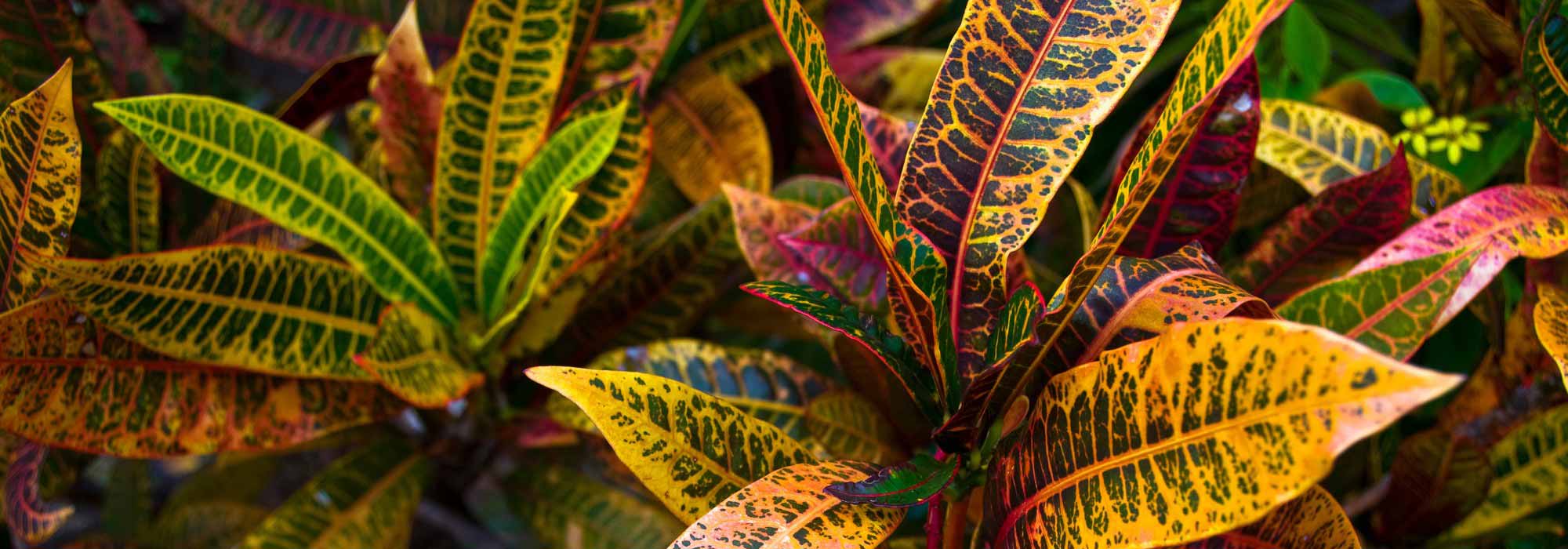
Croton: planting, growing, and care
Contents
Crotons in a few words
- The croton has evergreen and leathery foliage, beautifully variegated
- It forms a compact bush with a dense, bushy habit
- It is available in many cultivars with varied shapes and colours
- It requires strong light and a stable temperature to maintain its vibrancy
- An ideal ornamental plant for indoors, it adds an exotic and colourful touch
The word from our expert
The croton (Codiaeum) is a tropical plant prized for its spectacular foliage, blending shades of green, yellow, orange, and red. Native to Southeast Asia and the Pacific Islands, it captivates with its leathery leaves of varied shapes, sometimes lobed or undulate. Each specimen evolves over time, offering a colourful display that changes with the light and seasons.
However, this strong-willed plant is demanding and requires a bit of attention to thrive. The croton enjoys bright light and a warm atmosphere but fears drafts and sudden temperature changes, which can be fatal. Its lush leaf is a direct reflection of the care it receives: proper watering, non-calcareous water, and fertiliser in spring will ensure optimal growth. Repotting every two to three years is recommended to maintain its vigour, especially before winter. If you’re ready to provide a bright spot, sufficient humidity, and well-measured watering, the croton is an excellent choice to brighten your home with its vibrant leaves!
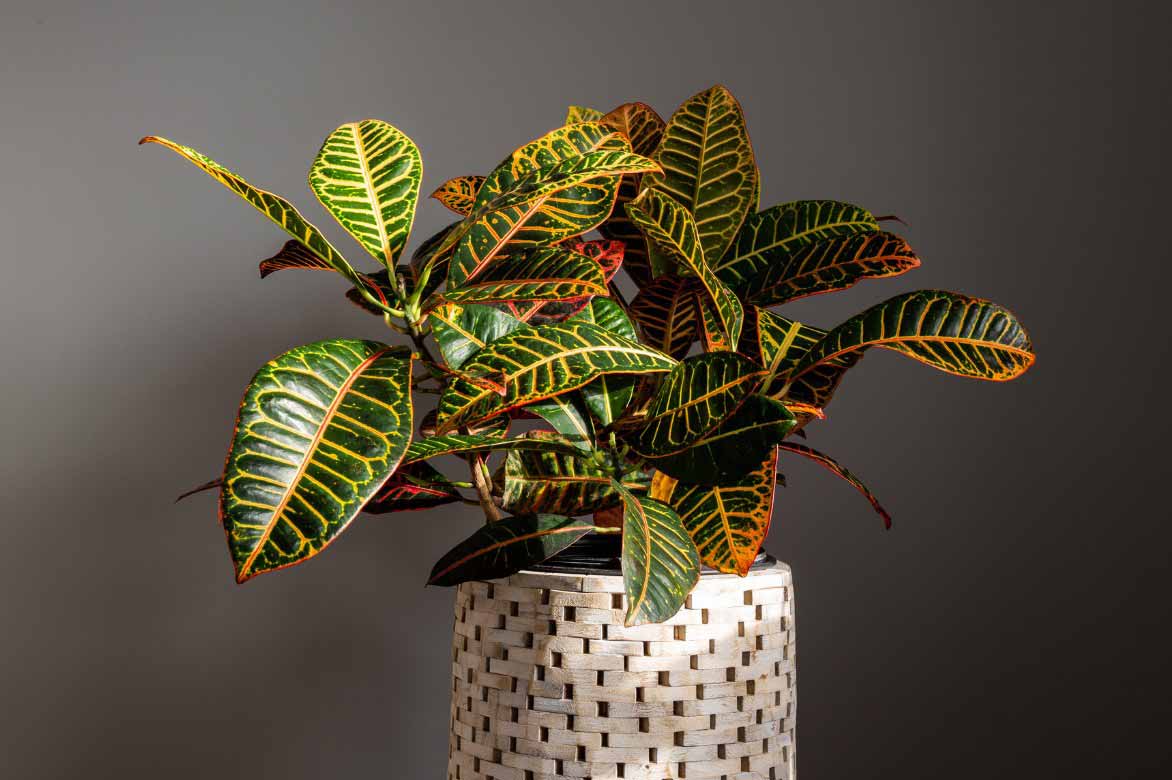
Botany and description
Botanical data
- Latin name Codiaeum
- Family Euphorbiaceae
- Common name croton
- Flowering rare indoors
- Height From 50 cm to 1.50 m indoors
- Exposure Bright
- Soil type Rich and well-draining
- Hardiness Frost-sensitive
The croton (Codiaeum) belongs to the Euphorbiaceae family, a vast family of plants that includes trees, bushes, and herbaceous plants. Some gardeners also nickname it the “variegated plant” due to its brightly coloured and ever-changing leaves. In its natural habitat, the croton thrives in the tropical climates of Southeast Asia and the Pacific Islands, where it grows in the understory, benefiting from the filtered light through the canopy and the ambient humidity. Its dense and colourful foliage allows it to capture maximum light, while its roots anchor in rich, well-draining soil.
The croton grown indoors primarily belongs to the species Codiaeum variegatum, but there are many cultivars offering a great diversity of leaf shapes and colours. Among the most widespread, the Codiaeum variegatum ‘Petra’ is one of the most popular, with its large ovate leaves and prominent veins, blending deep green, golden yellow, red, and orange. Other varieties, such as Codiaeum variegatum ‘Gold Dust’, stand out with their finer foliage, dotted with irregular yellow spots resembling paint splashes. Conversely, Codiaeum variegatum ‘Mrs. Iceton’ features elongated leaves in pastel tones, oscillating between pink, cream, and soft green.
The cultivars with narrow, curled foliage, such as Codiaeum variegatum ‘Zanzibar’, add a graphic touch with their long, slender leaves. Finally, the Codiaeum variegatum ‘Mammy’ stands out with a more compact habit and thick, twisted leaves, displaying a vibrant mix of red, yellow, and green.
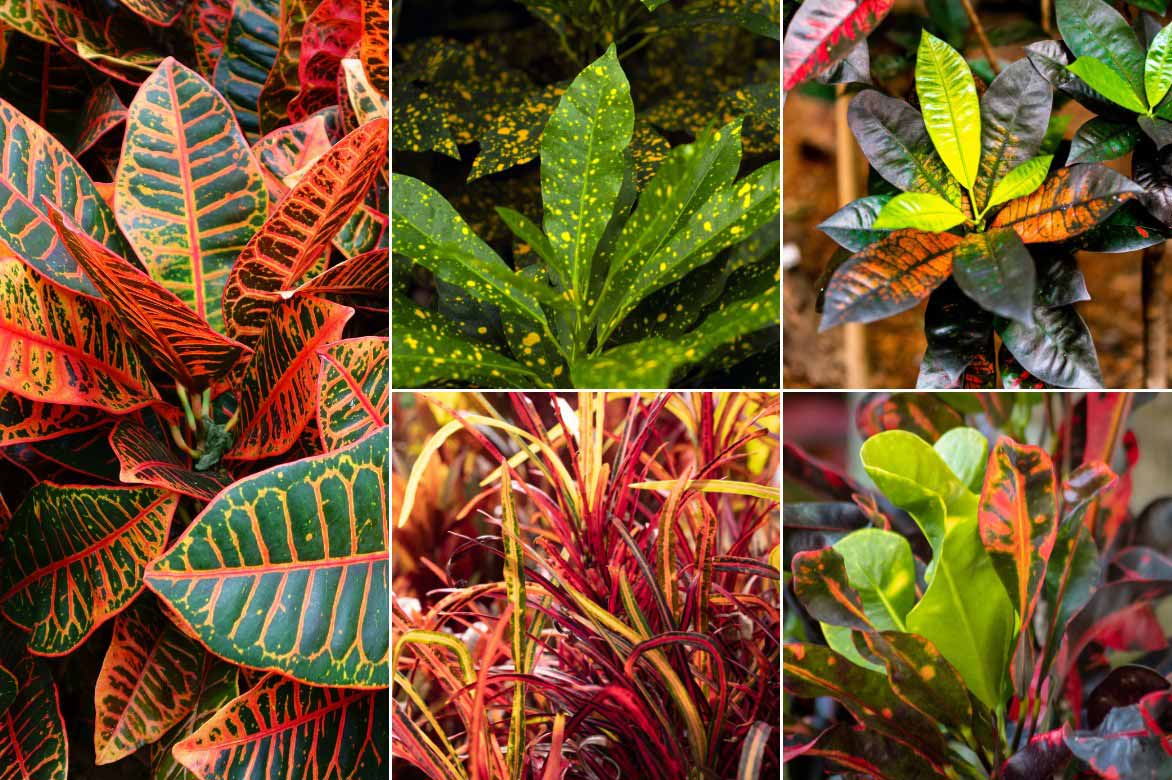
The croton offers foliage with varied colours and shapes. Here, the varieties ‘Petra’, ‘Gold Dust’, ‘Mrs Iceton’, ‘Zanzibar’, and ‘Mammy’
The croton takes the form of a compact, upright bush, often bushy when grown indoors. Its growth is relatively slow, and its development is influenced by growing conditions, but it can live for several years indoors with proper care. It reaches between 50 cm and 1.50 m in height, depending on the variety and maintenance. Its root system is relatively shallow but well-developed. The trunk, though discreet, is woody at the base and quickly branches into flexible stems bearing lush and exuberant foliage.
The croton’s foliage is its main asset. It bears evergreen leaves that, depending on the variety, can be elongated, ovate, lanceolate, lobed, or even spiralled, with smooth, undulate, or deeply cut edges. Their texture is thick and leathery, almost waxy. They are adorned with vibrant hues blending green, yellow, red, orange, and sometimes purple. These shades often mix on the same leaf, creating a marbled or veined effect, with patterns in spots, streaks, or mosaic. The veins are particularly prominent and often take on a contrasting shade, highlighting the foliage’s graphic appeal. This play of colours evolves with the leaf’s age and exposure, making each croton unique and ever-changing over time.
Indoors, flowering remains discreet and rare. When it occurs, it manifests as small whitish flowers gathered in light clusters, with little ornamental interest. In its natural environment, fruiting produces small capsules containing seeds, although this phenomenon is exceptional in domestic cultivation.
Thanks to its air-purifying ability, the croton helps improve indoor air quality by absorbing certain toxins present in the ambient air.
However, it should be noted that its sap is toxic if ingested and can cause skin irritation. It is therefore recommended to place it out of reach of children and pets.
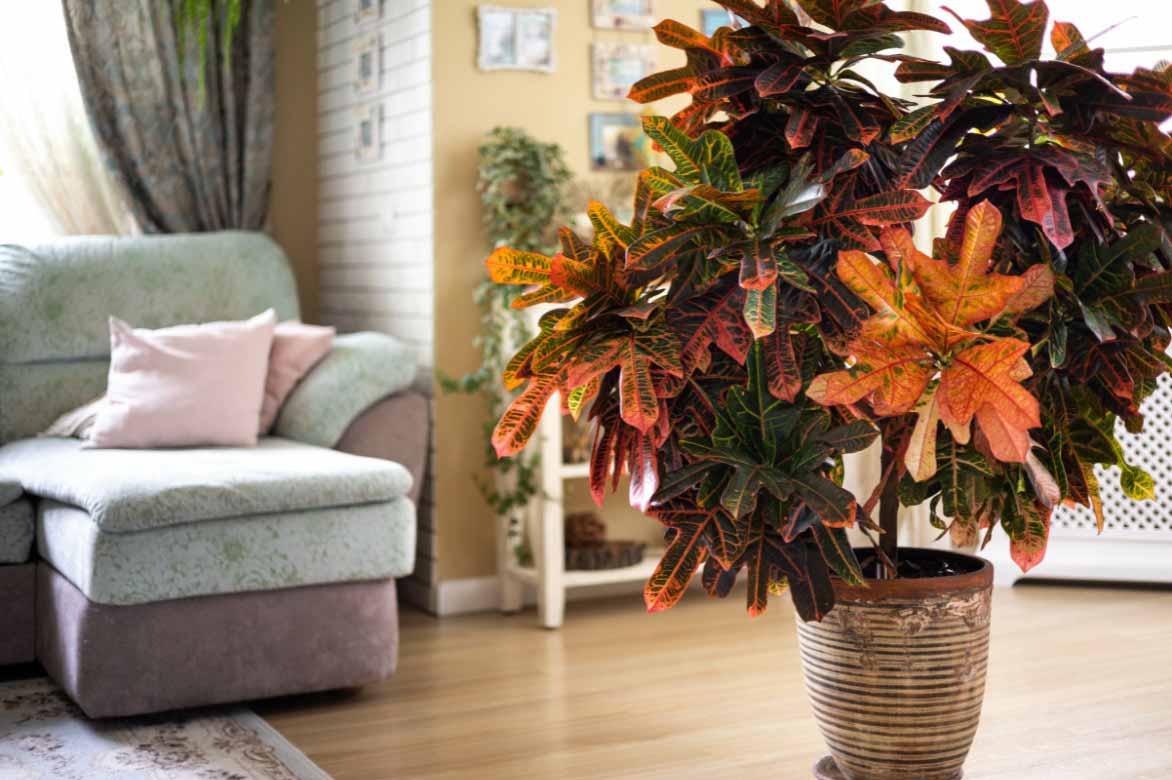
Over time, the croton grows tall and forms a bushy, branched bush, ideal for enlivening a living room with its colourful foliage!
Main species and varieties
What are the growing conditions for the Croton?
Where to Place the Croton?
The croton requires strong light to maintain the intensity of its colours. A spot near a well-lit window (without direct scorching sunlight, facing southeast or southwest) is ideal. It can tolerate light partial shade, but its colours will be less vibrant. The croton prefers bright, indirect light, which stimulates the production of colourful pigments in its leaves. If placed in a room that’s too dark, it may lose its flamboyant hues and develop predominantly green foliage.
This tropical plant needs a stable temperature, between 18 and 25°C. It dislikes the cold and cannot tolerate temperatures below 15°C. Frost-sensitive, it cannot be grown outdoors in temperate climates, except in summer, when it can be taken outside, provided it’s protected from drafts and sudden temperature changes.
Native to tropical regions, the croton thrives in humid air. Ambient humidity plays a key role in its health. Dry air can cause the foliage to dry out and leaves to drop prematurely. In a heated room during winter, compensate by misting regularly or using a humidifier to recreate an environment close to its natural habitat.
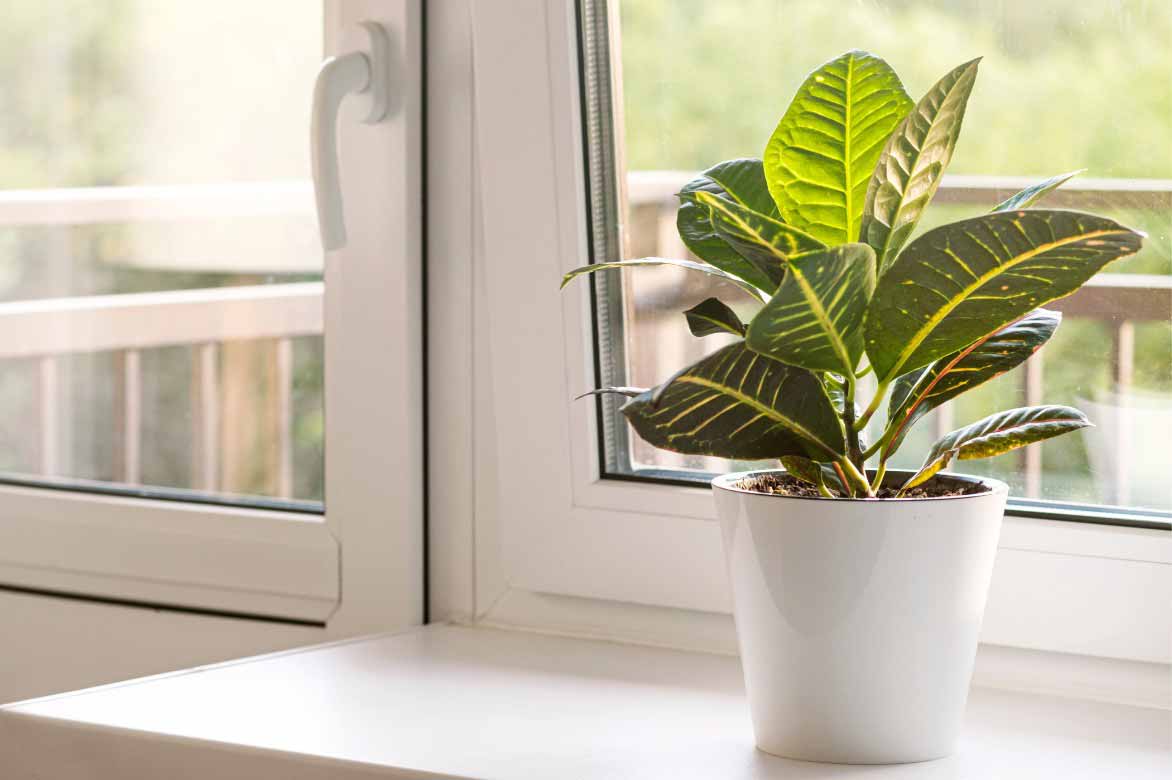
Place the croton in a bright spot, ideally near a window: this will intensify the colour of its foliage!
When to Plant It in a Pot?
The croton can be planted indoors all year round, provided the growing conditions are optimal. However, spring and summer are the best times to plant or repot it. The warmth and light encourage quick recovery and good adaptation to its new environment.
How to Plant a Croton in a Pot?
The pot must have drainage holes at the bottom to ensure good drainage and prevent waterlogging, which could cause root rot. Terracotta pots are recommended, as they allow better aeration of the roots, but a plastic pot will work as long as watering is carefully managed. A pot 2 to 3 cm wider than the root ball is ideal. The croton prefers to be slightly snug in its pot. A pot that’s too large may retain more moisture and slow growth.
What Substrate Should You Use?
The croton thrives in a light, well-draining substrate rich in organic matter. The ideal mix is equal parts houseplant compost, perlite, and turf.
Planting Steps
- Place a layer of drainage (clay pebbles, gravel) at the bottom of the pot.
- Mix the compost, perlite, and turf, then pour the substrate into the pot.
- Remove the croton from its pot, being careful not to damage the roots, then place the root ball in the centre of the pot.
- Add substrate around the roots, lightly firm it down, and water moderately.
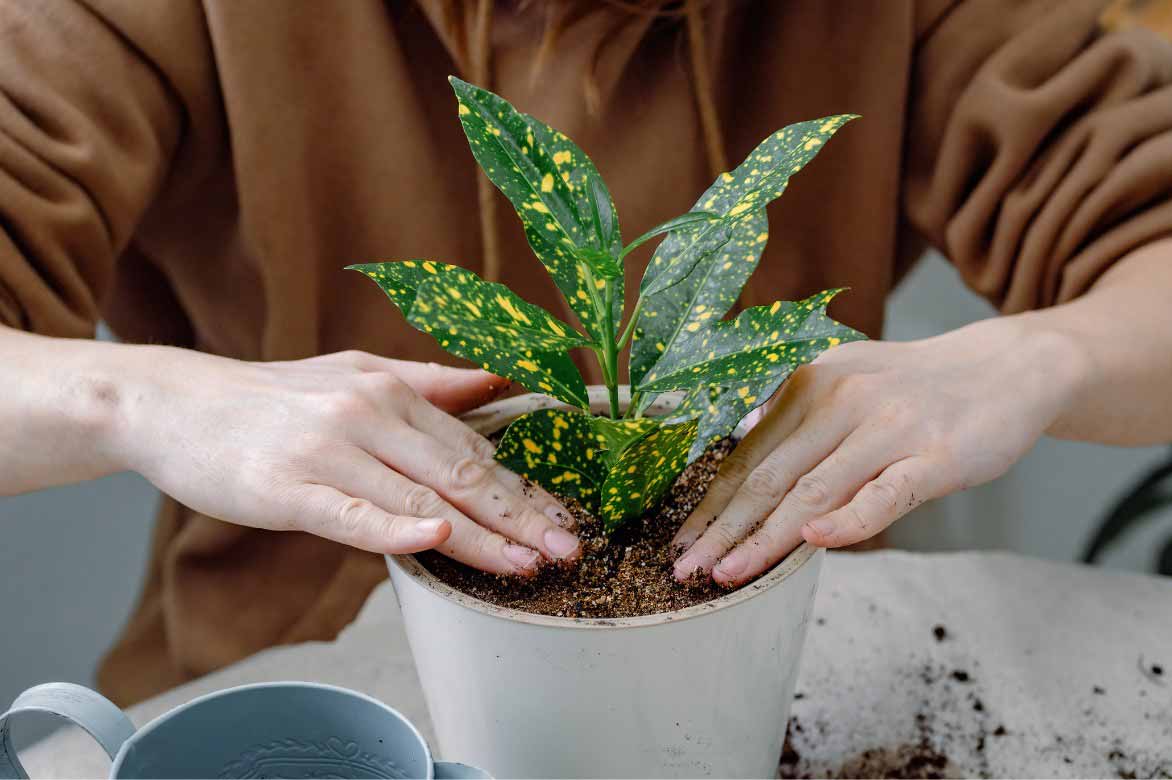
Plant the croton in a pot slightly larger than the root ball, in a light and well-draining substrate
How to care for a croton plant?
The croton is a demanding plant that requires special attention to maintain its colourful and healthy foliage.
When to water the croton?
Watering the croton should be regular but not excessive. It is essential to keep the substrate slightly moist, without ever soaking the roots, as this could cause them to rot. The watering frequency depends on the season:
- In spring and summer, when the plant is in full growth, it is advisable to water as soon as the surface of the compost begins to dry, approximately once or twice a week.
- In autumn and winter, growth slows down and evaporation decreases, so watering should be spaced out, waiting until the soil dries out several centimetres before adding water.
Ideally, use non-calcareous water at room temperature to avoid thermal shock. Additionally, regular misting of the foliage helps to recreate a humid atmosphere, which is beneficial for this tropical plant.
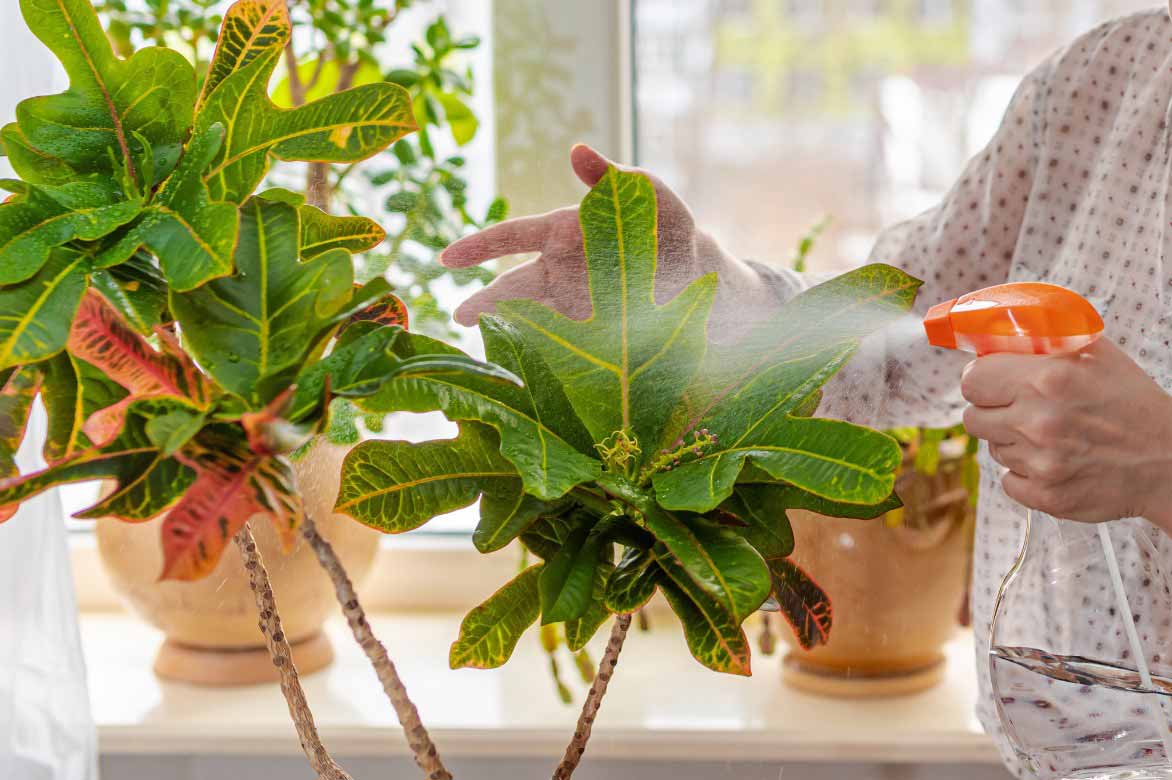
Don’t hesitate to mist the croton’s foliage regularly
Fertilisation: what fertiliser for the croton?
To support its growth and maintain the intensity of its colours, the croton requires regular nutrient inputs. During the growing period, between March and September, it is recommended to apply a liquid fertiliser for green plants every two to three weeks, to encourage dense and vigorous foliage. If you prefer to space out nutrient inputs, opt for slow-release fertiliser cones. In autumn and winter, fertiliser applications should be stopped, as the plant enters a dormant phase.
Pruning and foliage maintenance
The croton does not require strict pruning, but it is possible to pinch young shoots (by taking the tip of the shoot between your thumb and forefinger and pinching it off), to encourage denser branching and a more compact habit. Yellowed or damaged leaves should be removed to prevent them from unnecessarily draining the plant. It is also advisable to regularly clean the leaves with a damp cloth to remove dust and facilitate their respiration.
However, it is entirely possible to prune a croton if it becomes too large or loses density. Trimming the trunk can even encourage better branching and a more compact habit. When a croton stretches in height and becomes too bare at the base, it can be cut above a node, ideally in spring, to stimulate the appearance of new shoots. The cut should be made with a clean and sharp pruning shear. After pruning, the plant usually produces new branches from the buds below the cut, giving it a bushier appearance. Wear gloves when pruning, as the sap is slightly toxic and can cause skin irritation.
When to repot the croton?
Repotting the croton can be done every two to three years, in spring, when its roots begin to outgrow the pot. Choose a slightly larger pot. If the plant is too large to repot, top-dressing (replacing the top 3-4 cm of compost) may suffice to provide new nutrients.
Also read our advice in Croton: caring for this houseplant through the seasons.
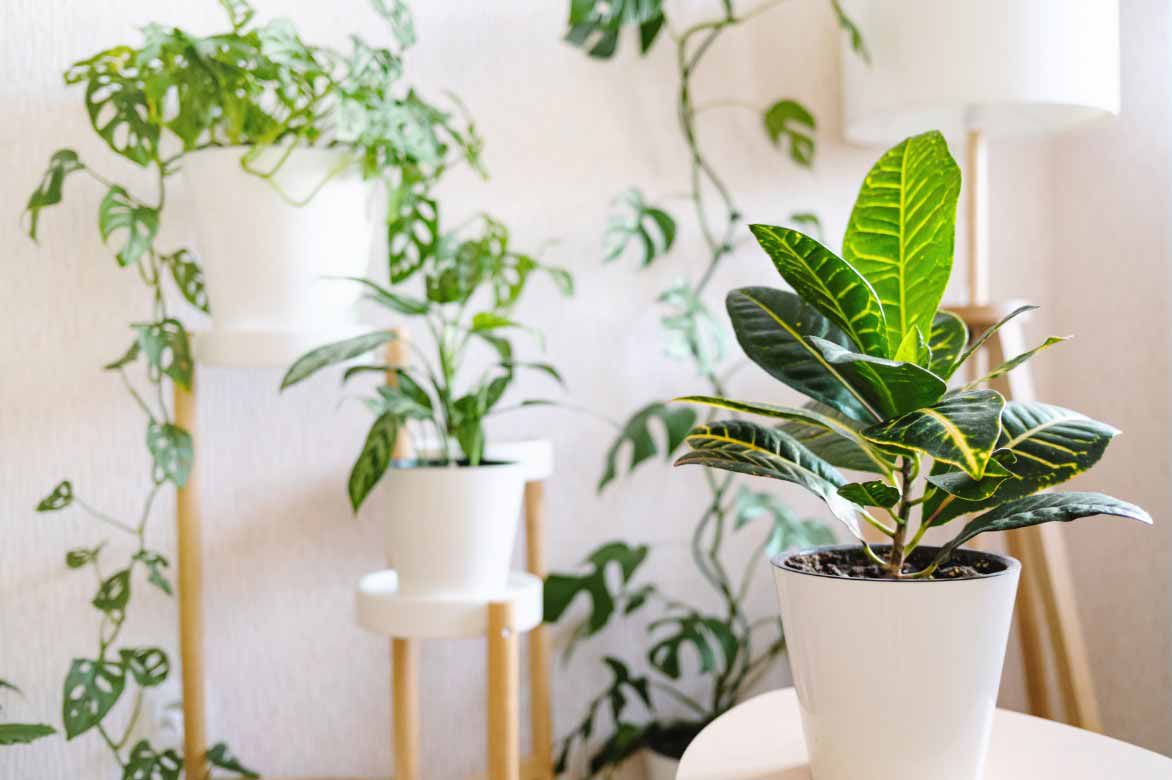
What are the common problems with Croton?
The croton is a magnificent plant with its colourful foliage, but it can be a bit temperamental! Here are the most common problems you might encounter and our advice on how to solve them:
- Leaf drop: This can be caused by various stresses such as drafts, sudden temperature changes, or water that is too hard or too cold. Avoid moving the croton too often, as it reacts poorly to changes in environment and may shed its leaves in response to stress.
- Yellowing or wilting foliage: This is often caused by overwatering or underwatering.
Pests and diseases of the croton
The croton is a hardy plant, but like all houseplants, it can be susceptible to certain pests and diseases, especially if its environment is not optimal.
The most common pests
The main pests affecting the croton are scale insects, spider mites, and aphids.
- Scale insects appear as small cottony clusters or brown shells attached to the leaves and stems. They feed on the sap and weaken the plant, leading to yellowing foliage. Treatment with a cloth soaked in 70° alcohol or diluted black soap in water can eliminate them.
- Spider mites appear when the air is too dry. They spin fine webs under the leaves and cause discolouration. Increasing ambient humidity and spraying water on the foliage can help control them.
- Aphids, though less common, can colonise young shoots and distort the leaves. A treatment based on black soap helps eliminate them.
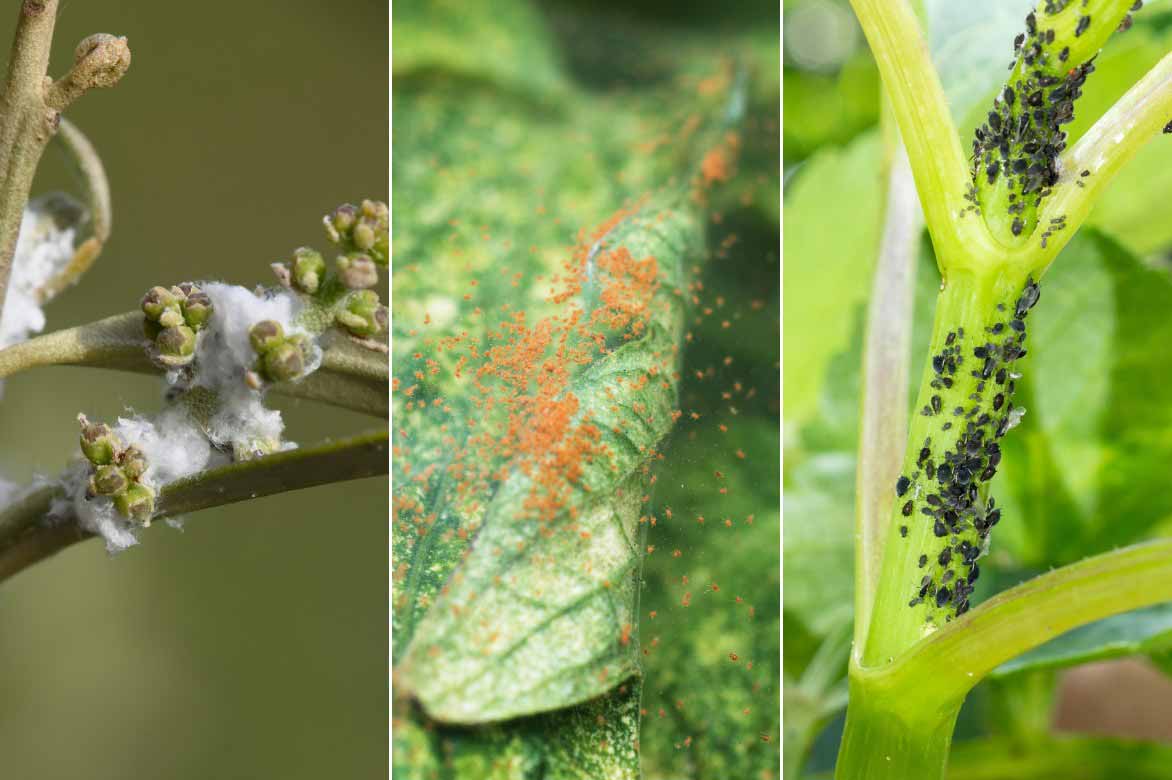
Scale insects, spider mites, and aphids
Common diseases
The croton is particularly susceptible to problems related to excess moisture or poor drainage.
- Root rot occurs when the substrate remains waterlogged for too long. It manifests as blackening of the collar and a drooping plant. To avoid this issue, it is essential to use a well-draining pot and space out watering.
- Foliage decline can be caused by sudden temperature fluctuations, lack of light, or overly dry air. A stable environment and good humidity levels are essential to prevent this.
- Leaf spots sometimes appear when the watering water is too cold or if the plant receives water droplets in direct sunlight. It is best to water with room-temperature water and avoid wetting the foliage when it is in the sun.
Also read our detailed guide: Indoor croton: pests, diseases, and common problems.
How to propagate croton?
The croton is mainly propagated by cuttings, but it can also be reproduced by layering or sowing, although these methods are less commonly used. Propagation by cuttings in water is a simple technique that stimulates root growth before replanting the cutting in soil.
How to propagate a croton in water?
- Choose a healthy stem about 10 to 15 cm long, with several leaves.
- Cut the stem just below a node using clean pruning shears.
- Keep only the upper leaves to reduce evaporation.
- The croton produces a milky sap; it is recommended to let the cut dry for a few minutes before placing it in water.
- Use water at room temperature and submerge only the base of the stem.
- Change the water every 3 to 4 days to prevent the proliferation of bacteria.
- The first roots usually appear within 2 to 4 weeks.
- When the roots are 2 to 5 cm long, transplant the cutting into a light, well-draining substrate.
- Water lightly and place the plant in a bright spot without direct sunlight.
Decorative touch: how to showcase a Croton in your interior?
The croton, with its colourful and graphic foliage, is an ideal plant to add vibrancy to a living room or office. To showcase it, it’s best placed in a bright space where its striking hues can fully shine. In terms of décor, it works particularly well as a standalone plant, on a pedestal or coffee table, where it becomes a true focal point. It can also be incorporated into a composition with other tropical plants, such as the monstera, the ficus, or the calathea.
As for the pot, it is best showcased in simple and elegant containers, which avoid overwhelming the already strong visual impact of its foliage. A raw terracotta pot adds a natural and authentic touch, perfect for a bohemian or Mediterranean style. For a more modern and minimalist look, a white or black ceramic pot will highlight its colours without overpowering them. Plant covers made from natural materials, like rattan, enhance its exotic and lush appeal without being kitschy.
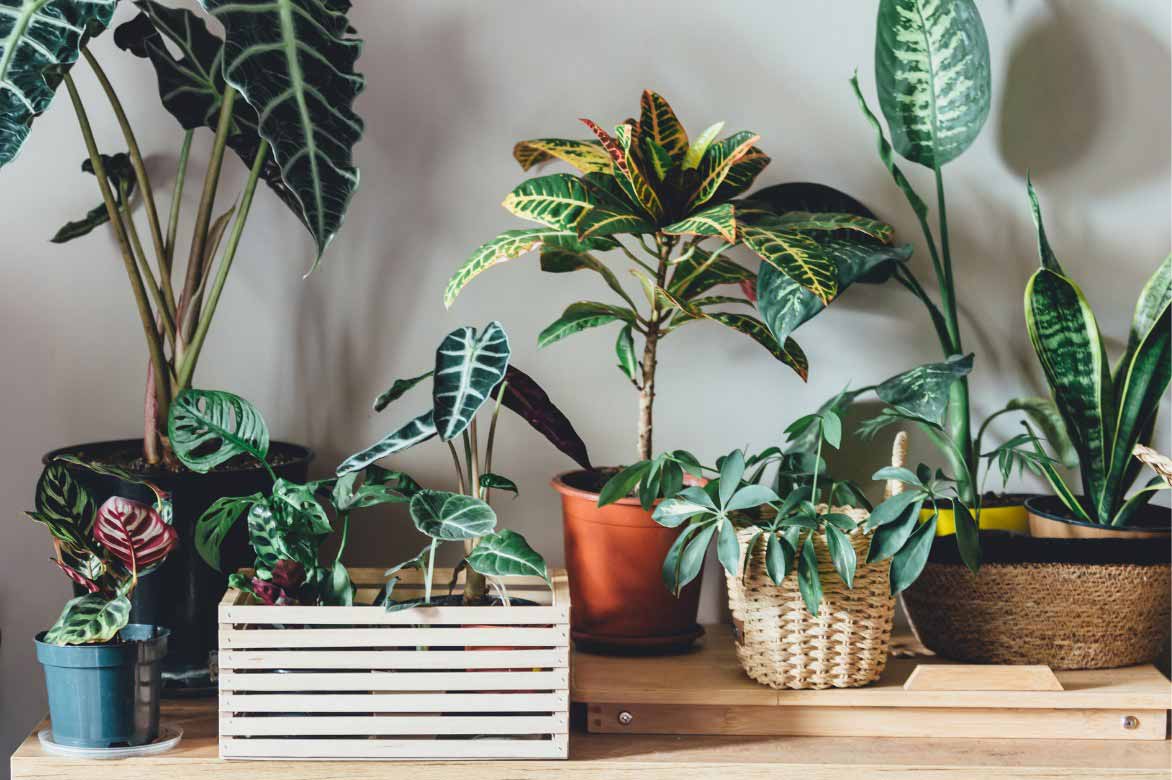
Pair the Croton with other houseplants such as Calathea, Alocasia, Sanseveria…
Also see
→ Discover our wide range of houseplants.
Frequently asked questions
-
How to get rid of fungi on my croton?
To eliminate fungi on your croton, start by isolating the plant to prevent any spread. Prune the affected parts by removing the leaves or stems showing suspicious spots. A natural treatment can be applied, such as a solution of baking soda diluted in water or a horsetail decoction, to spray on the foliage. It is essential to improve air circulation around the plant and avoid excessive humidity by reducing watering and ensuring the leaves are not wet. Good drainage of the soil will also limit the appearance of new fungal infections.
-
Why is my croton losing all its leaves?
The loss of leaves in a croton is often due to a sudden change in environment, inappropriate watering, or unfavourable growing conditions. Recent relocation, a lack or excess of water, temperatures that are too low, or overly dry air are the most common causes. A lack of light or cold drafts can also weaken the plant. If these factors are managed, the croton will gradually regain its foliage.
- Subscribe!
- Contents
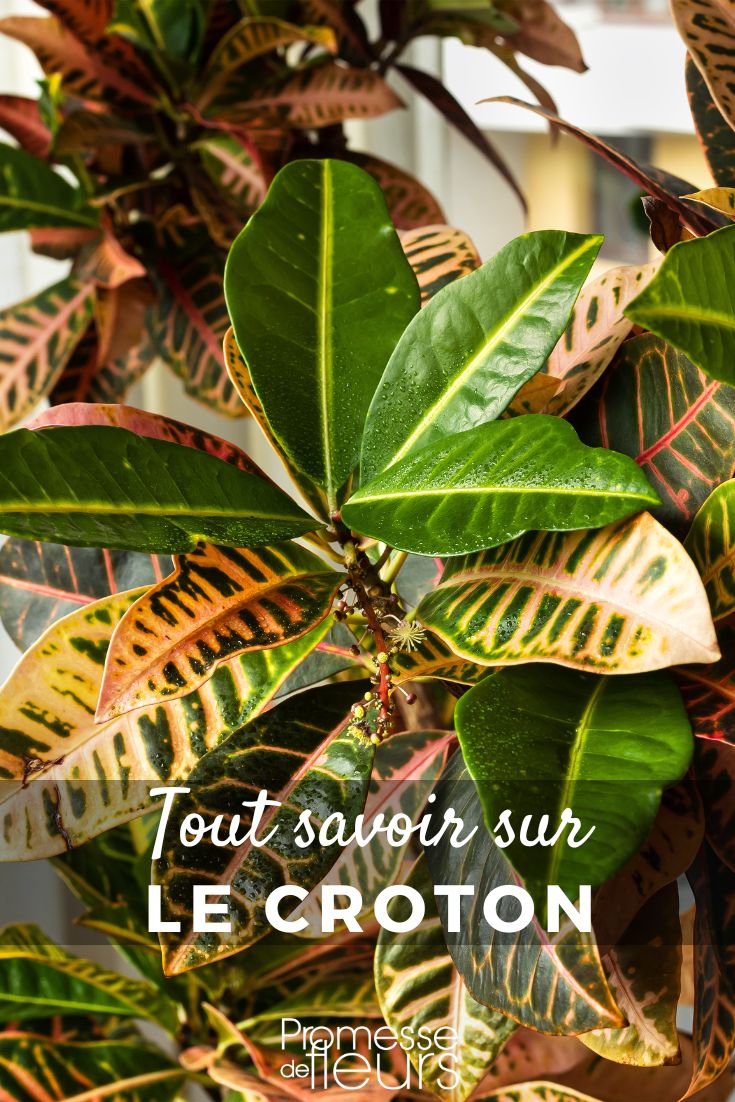































Comments